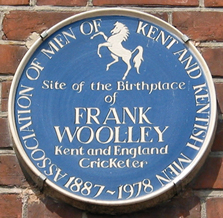Tonbridge cricketers
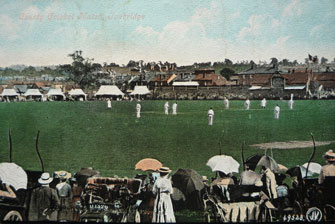
A county match on Tonbridge's Angel Ground in the early years of the twentieth century.
The site is now occupied by Sainsbury's, Beale's, the Angel Centre and their
associated car parks.
From the earliest days of the game, Kent has been a very strong
cricketing county. This strength was due mainly to its seedbed in Tonbridge
where the county Nursery, at which young players were nurtured, was located on
the town’s Angel Ground from 1897 to 1927. It was managed by Tom Pawley, who was
also manager of the Rose & Crown hotel. He was an ex-Kent cricketer and had at
one time been appointed to manage the Kent team. Cricket for many Tonbridgians
was more than just a Saturday afternoon pastime; it was a way of life – and for
some in the town it provided a living. Between the wars, the Cricket Week
festivities were the highlight of Tonbridge's summer season.
Three of Tonbridge's finest players are profiled below, but there have been
many others almost equally deserving of mention: Doug Wright, ‘Hopper' Levett,
Alan Watt, Tich Freeman, Leslie Ames, and Arthur Fagg. The last of these, on leaving Sussex Road School, soon established a place in the
Kent side as an opening bat and followed this by playing for England. He remains
to this day the only first class player to score a double century in each
innings of a match, something he achieved
playing for Kent against Essex at Colchester in 1938.
Colin Blythe
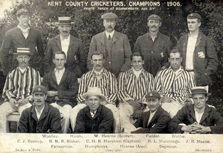
The Kent team who won the County Championship in 1906. Blythe is at back right, Woolley at back left.
(THS31C.07)
Colin Blythe was born in 1879 in Deptford, but he learnt his cricket in the
Nursery at the County Ground in Tonbridge. He was a slow left arm bowler and
there was beauty as well as deadliness in his bowling. The rhythm in his action
and his mastery of flight and spin were poetic. ‘Charlie’, as he was known, took
2,506 wickets at 16.81 runs each for Kent and played 19 times for England.
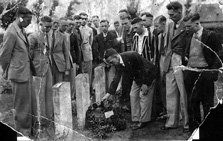
Members of the Welsh Dragons cricket team pay homage at the grave of Charlie
Blythe in 1933. (Photo supplied by Paul Sambrook)
Blythe
was on the point of retiring when the First World War broke out: to the dismay
of his colleagues and of the general public he was killed in action in 1917. He
is buried in the Oxford Road Cemetery near Ypres in Belgium but there is a memorial to him in Tonbridge Parish Church,
and a road in North Tonbridge bears his name.
Frank Woolley

Woolley contributed 172 to Kent's highest-ever score of 804 for 4 (wrong on the scoreboard) in 1934. He is the tallest of the three players shown.
(THS31C.44)
Frank Woolley, born and bred in Tonbridge, also learnt his cricket at the
Tonbridge Nursery. He brought grace and colour to Kentish cricket throughout his
career from 1906 to 1938. He made 145 hundreds and scored 58,961 runs and bowled
very effective slow left-arm. He played 64 times for England. But the quality
that endeared him to crowds over the years was the grace and majesty of his
left-handed batting. Neville Cardus wrote: ‘No other cricketer served the meadow
game as happily and faithfully as Woolley’.
Woolley's childhood home was his father’s
cycle and engineering shop at 72 High Street, barely 100 yards from the Angel
Ground. The house was later demolished for road widening, and replaced by what
is now Starbucks. There is a plaque to him on the wall facing the High
Street. He is also commemorated in the Parish
Church and by a road in North Tonbridge.
Colin Cowdrey
Colin Cowdrey was a pupil at Tonbridge School between 1945 and 1950. He first
appeared at Lords at the age of 13 and went on to become captain of Oxford, Kent
and England. He first played for Kent in 1950 and led them to win the Gillette
Cup in 1967 and the Championship in 1970. In all he made 23,779 runs for the
county and over 100 centuries. He played for England 114 times, 27 of them as
captain. In later life Cowdrey made a major contribution to the
administration of world cricket, as President of the MCC and Chairman of the
International Cricket Council. He was deeply involved in measures to preserve
all that is best in cricket from the aggressive trends in the modern game, and
brought charm, courtesy and dignity to cricket the world over. He was knighted
in 1992 and made a life peer, Baron Cowdrey of Tonbridge, five years later. He
died in 2000. Two of his sons played for Kent and one of them, Christopher, also
played for England.
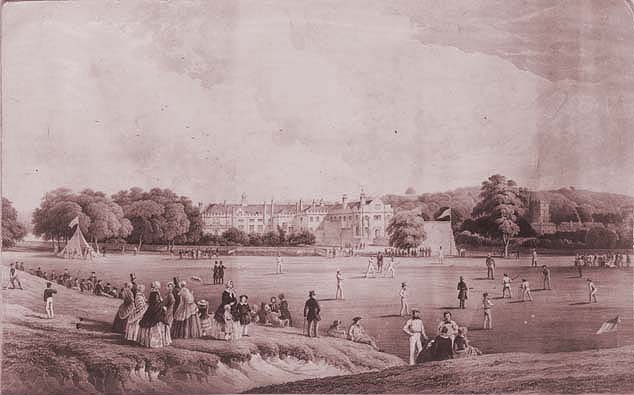
Tonbridge School's hallowed first eleven cricket ground, known as 'The Head',
was levelled in about 1840 using surplus soil – and navvies – from the
construction of the railway. This well-known print shows it as it was in 1851. It was here that Colin Cowdrey
began his spectacular career in the 1940s. (THS12.051)
More detailed biographies are on the 'Cricinfo'
website here:
Blythe,
Woolley,
Cowdrey.
▲Top





